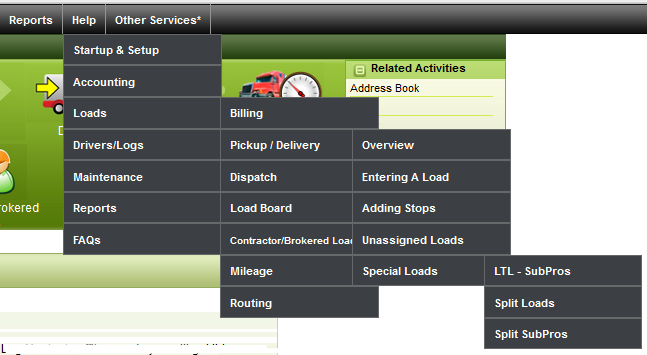Definitions
LOAD: is equated to an invoice and to a truck load. If you have one broker or shipper who is paying for a load, that is one Pro Number and a basic load. A load can be a trailer full or a partial. Several partials can be put on the trailer at the same time and they will also be considered a 'trailer load' which is comprised of several smaller loads. Consider in this manual that a load is the same thing as an invoice - it refers to the specific freight that will be billed to one certain customer. In some cases, a broker for example, you might have one person being billed, but they are tendering several separate loads and want each load billed separately. In that case each separate invoice would constitute its own 'load'. So 'load' as used here can have multiple meanings and it's important to understand the different meanings and how they relate to each other and to the truck/trailer that haul them.
THE STRAIGHT LOAD: A single pickup and a single delivery. This is the easiest type of load and the most straight forward. You enter who you will bill for the load here, then move to Pickup/Delivery and enter where the load will pickup and where it will deliver. The pickup is RUN ORDER (RO) 1 and the DELIVERY is RO 2.
LTL & SubPro LOADS: If you have two or more companies who are paying you for a load then you have a SubPro load. The program handles this by using one Pro Number, 1000 for example, and then adding a letter after it for each customer who will be billed. So if you have 3 invoices for this load they will be for 1000A, 1000B & 1000C. This type of load can be any mix of pickups & deliveries, the key to defining each portion of the load is who is billed for it. So you will have a letter for each separate invoice required to bill the load.
SPLIT LOADS: Split loads occur when you have one truck pickup a load and another truck deliver it or when you pickup, bring the load to the yard, have the truck that picked it up run other loads, then pick the trailer up again and delivery it. To handle this type of load we'll use a P on the end of the Pro Number for the Pickup and a D on the end of the Pro Number for the Delivery. So you'd have 1000P for the pickup, which would then deliver to the Trailer Swap location and 1000D for the load that would go from the Trailer Swap to the actual Delivery. If you have more than a two trucks involved the program can handle that as well. The original pickup would be P, the final delivery D, the third truck involved if it was before the pickup would be PP, if it was after the pickup it would be DD.
SPLIT SUBPROS: Split SubPros can occur when you have more than one truck involved in a SubPro type of load. Generally this is one of those things that occurs due to a truck break down rather than a planned SubPro trip with multiple trucks involved, but either way the program can handle it. In this case you'll use a combination of SubPros and the P & D portions to define the load. For actual entry examples see the individual topic for each load type and refer to the input examples that are shown and detailed in the tutors -

HELP>LOADS>PICKUP>DELIVERY>SPECIAL LOADS will get you to the tutors for these types of loads.